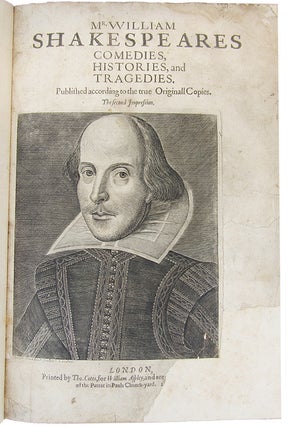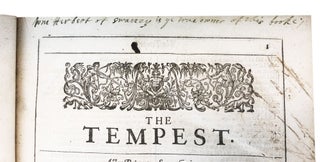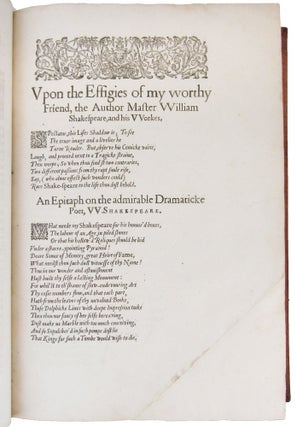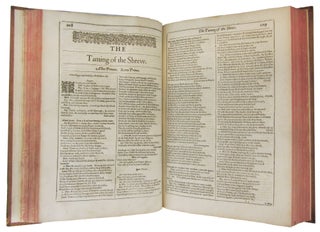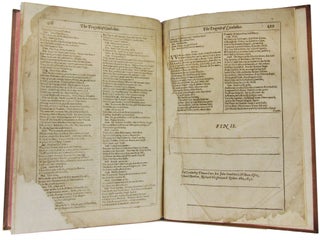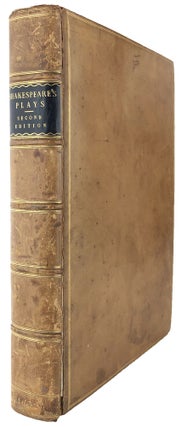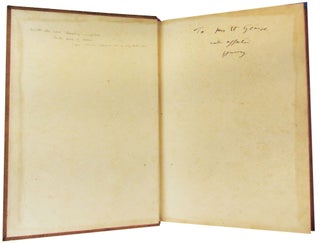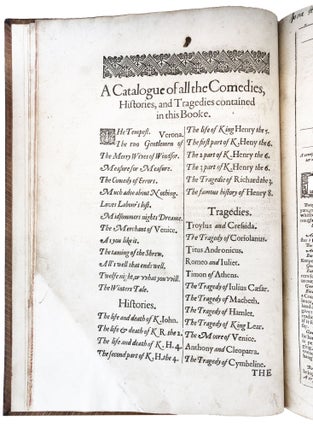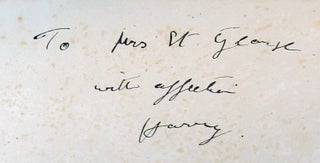COMEDIES, HISTORIES, AND TRAGEDIES. Published according to the true Originall Copies. The Second Impression.
Pp. [xviii of xx]+304+232+420 (by signature: A[2]-6, *4, A6-Z6, Aa6-Zz6, aaa6-ddd4), engraved portrait of Shakespeare by Martin Droeshout on title page, with woodcut ornaments, initials and headpieces throughout, the text of the plays printed double column within single rule borders; folio in sixes (33.27 cm. x 22.86 cm); early 19th century calf, boards with triple gilt rule borders, later (not recent) gilt lettered black leather title label on spine, the boards a trifle marked and slightly rubbed, joints worn and cracking, spine lightly worn; all edges red; inked (20th century) gift inscription (donor and recipient unknown) on upper free endpaper, a few small damp stains to margins, 5 tiny holes to the first page of The Comedy of Errors (with slight loss of 3 letters of text), a couple of short closed marginal tears, a little slight soiling and browning; London, Printed by Tho. Cotes, for William Aspley, and are to be sold at the signe of the Parrat in Pauls Church-yard. 1632. STC 22274b; ESTC S1620. Condition: Lacking the initial leaf, To the Reader, but with all other leaves present and mostly intact. The first 17 and last 19 leaves have been neatly repaired (not recently), with some loss of the ruled border and/or varying degrees of minor text loss to 25 of those leaves, usually only a few words or less to the last few lines. The title and colophon pages have both been laid down, and there is some loss of the imprint at the foot of the title page, including almost all of the date. (The text that remains is: London, Printed by Tho. Cotes, for William Aspley, and are [...] of the Parrat in Pauls Church-yard. 1...). The inner margin of the final leaf has loss of much of the ruled border, portions of each of the last 17 lines of text (usually only a couple of words per line), and the beginning of the two-line colophon: the first word of line one, and part of the initial 'R' from the first word of line two. The five publisher's names and, most importantly, the 1632 date are all intact. The title page portrait of Shakespeare by Martin Droeshout is in the third state, with the tiny difference in the highlighting of the eyes and the extra strand of hair to the right side of the coiffure. The letter 'M' is missing from the artist's name, but the portrait is complete and a fine impression. The Droeshout portrait is generally accepted as one of only two images of Shakespeare that are probably a true likeness of him (the other being his funerary monument in Holy Trinity Church, Stratford-upon-Avon). The Effigies leaf, containing Milton's poem An Epitaph of the admirable Dramatick Poet, W. Shakespeare, is in state C, with, amongst other points, 'comicke' in line 6, 'passions' with ligatured double 's' in line 9, 'Shakespeare' (line 13) in Roman type, and 'starre-ypointing Pyramid' in line 4 of Milton's Epitaph. This is the first published poem by John Milton. The watermark for this sheet is not visible, presumably obscured when the conjugate title page was laid down. All 36 plays are present, in the correct order. After the 18 [of 20] un-numbered preliminary leaves, the text is paginated in three sections: 1-304(last blank), 1-232, 1-420(last blank). There are several irregularities in both pagination and signatures, including a jump of 100 pages in the third section, where page 168 is followed by 269, with the misnumbering continuing to the end (thus the last printed page, numbered 419, should be 319). The dedication leaf is signed A2 instead of A3, and in the third section of the plays cc is signed as a second bb. Most extant copies of the Second Folio, which was published nine years after the First Folio, are in some way defective. Despite the internal flaws mentioned, this is a predominately fine, tall and clean copy of one of the scarcest Second Folio imprints: that of William Aspley. The five publishers (John Smethwick, William Aspley, Richard Hawkins, Richard Meighen, and Robert Allot) all owned copyright of at least one of Shakespeare's plays and each had a variant of the title page published bearing their name. The partners in the syndicate were allocated different numbers of copies to sell in their respective shops, the size of each consignment being determined by the number of rights they held. Of all the variant title pages, the most common imprint is that of the major publisher, Richard Allot, and all copies of the Second Folio in Australian institutional libraries are variations of the Allot imprint. William Aspley, who unlike Allot was also a partner in the First Folio, owned the rights to only two plays (Much Ado About Nothing and Henry IV, Part 2); consequently, the proportion of copies issued with his imprint was relatively small. Extrapolating from William B. Todd's calculations (The Issues and States of the Second Folio and Milton's Epitaph on Shakespeare, pages 95-6), Aspley's allocation could have been as few as 50 copies. (The total edition is thought to have been 1,000, of which approximately 250 are known to exist). Jaggard (page 496) describes the Aspley imprint as 'the rarest of the variations'. Provenance: This copy bears an early, perhaps contemporary, inked ownership inscription at the head of the first play, The Tempest: 'Wm Herbert of Swanzy is ye true owner of this booke'. This early (and presumably first) owner could be one of several William Herberts in seventeenth century Wales. Perhaps the most likely candidate is the politician of that name who was born in 1587. His father, Richard, had settled on an estate near Swansea owned by Richard's wife, so presumably this William Herbert was born there. He was elected Member of Parliament for Cardiff in 1621 and was later Mayor of Cardiff and Constable of Cardiff Castle in the 1630s. After a brief residence in London, this William Herbert bought land and coal mines in the parish of Llansamlet, near Swansea. Confusingly, several of his relatives were also called William Herbert, the most notable of these being the third Earl of Pembroke (1580-1630), whose mother resided at nearby Cardiff Castle. William Herbert MP collected rents in South Wales for the fourth Earl, Sir Philip Herbert. When he died in 1645, William Herbert's estate was reckoned at 1,000 pounds per year, so he would have been able to afford to buy the book - in which there would have been some family interest, as the third Earl of Pembroke and his brother and successor Philip were the two dedicatees of the First (and Second) Folio. It has been suggested that William, the third Earl, could have been the 'Fair Youth' to whom Shakespeare addressed many of his Sonnets, and he has also been proposed as a candidate for the mysterious 'Mr. W. H.' who is described in the 1609 edition as 'the onlie begetter' of the Sonnets. In 1951, Maggs Bros., London, offered this copy of the Second Folio for sale for 205 pounds in their Catalogue 800 (English Literature prior to 1800. PART 7 S-Z). It was purchased by Australian book collector Keith McRoberts, a regular customer of the firm. Born in Melbourne, Keith McRoberts, and his wife Gwen (nee Blogg), came from longstanding wealthy Victorian business families, both in the industrial chemist trade. Keith's father, Henry Gavinus McRoberts, was the founding Chairman of the Board of Drug Houses of Australia Pty Ltd when it listed on the Stock Exchange circa 1930. It brought together all the major pharmaceutical families across Australia and by the 1960's was Australia's largest pharmaceutical company. Soon after they were married, Keith and Gwen moved to Brae Springs near Gerogery, N.S.W. Brae Springs was owned by Keith's father, and was used to breed racehorses in partnership with J. G. Heywood. In the late 1930s/early 1940s Keith and Gwen bought Bungowannah Park, near Albury, becoming prominent citizens in the area. (Princess Alexandra stayed with the McRoberts at Bungowannah Park when she visited Albury during her tour of Australia in 1959. An article in The Border Morning Mail for 17 September 1959 notes that she 'had an opportunity of seeing a valuable collection of books in Mr. McRoberts' personal library'). Keith McRoberts was an avid collector of books and art, buying both locally and overseas. (The eminent Australian scholar and book trade historian, Professor Wallace Kirsop, recalls seeing mention of Keith McRoberts as a customer in the archives of Melbourne bookseller, A. H. Spencer, of Hill of Content fame). After Keith's death in 1967, many of the books in his 'gentleman's library' were purchased by Maggs Bros., but his Second Folio Shakespeare has remained in the care of his family for the last 55 years. Item #165224
Price: $450,000.00


